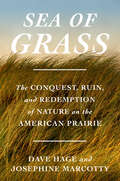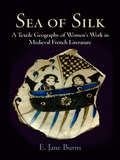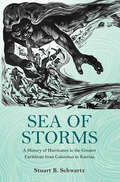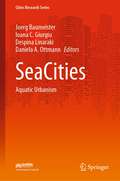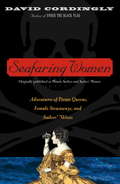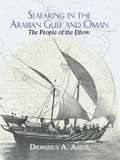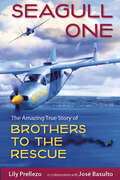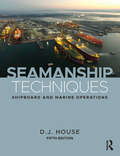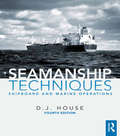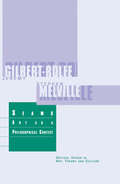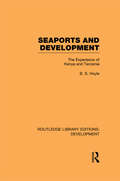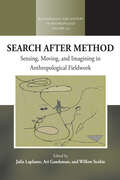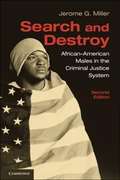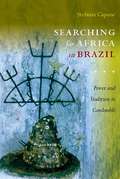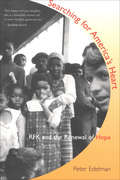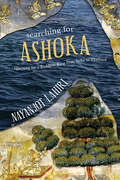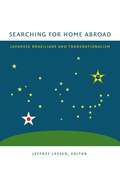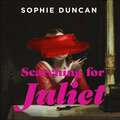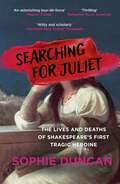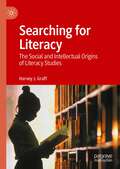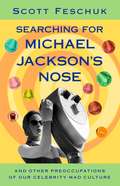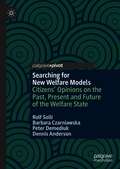- Table View
- List View
Sea of Grass: The Conquest, Ruin, and Redemption of Nature on the American Prairie
by Dave Hage Josephine MarcottyA vivid portrait of the American prairie, which rivals the rainforest in its biological diversity and, with little notice, is disappearing even faster&“This book describes—in loving, living prose—one of the world&’s greatest and most important landscapes. And it does so while there&’s still time to save some serious part of it.&”—Bill McKibben, author of The End of NatureThe North American prairie is an ecological marvel, a lush carpet of grass that stretches to the horizon, and home to some of the nation&’s most iconic creatures—bison, elk, wolves, pronghorn, prairie dogs, and bald eagles. Plants, microbes, and animals together made the grasslands one of the richest ecosystems on Earth and a massive carbon sink, but the constant expansion of agriculture threatens what remains.When European settlers encountered the prairie nearly two hundred years ago, rather than a natural wonder they saw an alien and forbidding place. But with the steel plow, artificial drainage, and fertilizers, they converted the prairie into some of the world&’s most productive farmland—a transformation unprecedented in human history. American farmers fed the industrial revolution and made North America a global breadbasket, but at a terrible cost: the forced dislocation of Indigenous peoples, pollution of great rivers, and catastrophic loss of wildlife. Today, industrial agriculture continues its assault on the prairie, plowing up one million acres of grassland a year. Farmers can protect this extraordinary landscape, but trying new ideas can mean ruin in a business with razor-thin margins, and will require help from Washington, D.C., and from consumers.Veteran journalists and midwesterners Dave Hage and Josephine Marcotty reveal humanity&’s relationship with this incredible land, offering a deep, compassionate analysis of the difficult decisions as well as opportunities facing agricultural and Indigenous communities. Sea of Grass is a vivid portrait of a miraculous ecosystem that makes clear why the future of this region is of essential concern far beyond the heartland.
Sea of Silk
by E. Jane BurnsThe story of silk is an old and familiar one, a tale involving mercantile travel and commercial exchange along the broad land mass that connects ancient China to the west and extending eventually to sites on the eastern Mediterranean and along sea routes to India. But if we shift our focus from economic histories that chart the exchange of silk along Asian and Mediterranean trade routes to medieval literary depictions of silk, a strikingly different picture comes into view. In Old French literary texts from the twelfth and thirteenth centuries, emphasis falls on production rather than trade and on female protagonists who make, decorate, and handle silk.Sea of Silk maps a textile geography of silk work done by these fictional women. Situated in northern France and across the medieval Mediterranean, from Saint-Denis to Constantinople, from North Africa to Muslim Spain, and even from the fantasy realm of Arthurian romance to the historical silkworks of the Norman kings in Palermo, these medieval heroines provide important glimpses of distant economic and cultural geographies. E. Jane Burns argues, in brief, that literary portraits of medieval heroines who produce and decorate silk cloth or otherwise manipulate items of silk outline a metaphorical geography that includes France as an important cultural player in the silk economics of the Mediterranean.Within this literary sea of silk, female protagonists who "work" silk in a variety of ways often deploy it successfully as a social and cultural currency that enables them to traverse religious and political barriers while also crossing lines of gender and class.
Sea of Storms
by Stuart B. SchwartzThe diverse cultures of the Caribbean have been shaped as much by hurricanes as they have by diplomacy, commerce, or the legacy of colonial rule. In this panoramic work of social history, Stuart Schwartz examines how Caribbean societies have responded to the dangers of hurricanes, and how these destructive storms have influenced the region's history, from the rise of plantations, to slavery and its abolition, to migrations, racial conflict, and war.Taking readers from the voyages of Columbus to the devastation of Hurricane Katrina, Schwartz looks at the ethical, political, and economic challenges that hurricanes posed to the Caribbean's indigenous populations and the different European peoples who ventured to the New World to exploit its riches. He describes how the United States provided the model for responding to environmental threats when it emerged as a major power and began to exert its influence over the Caribbean in the nineteenth century, and how the region's governments came to assume greater responsibilities for prevention and relief, efforts that by the end of the twentieth century were being questioned by free-market neoliberals. Schwartz sheds light on catastrophes like Katrina by framing them within a long and contentious history of human interaction with the natural world.Spanning more than five centuries and drawing on extensive archival research in Europe and the Americas, Sea of Storms emphasizes the continuing role of race, social inequality, and economic ideology in the shaping of our responses to natural disaster.Some images inside the book are unavailable due to digital copyright restrictions.
SeaCities: Aquatic Urbanism (Cities Research Series)
by Joerg Baumeister Daniela A. Ottmann Ioana C. Giurgiu Despina LinarakiThis book highlights the research outcome of Cities Research Institute's SeaCities group at Griffith University and a panel with the same title which took place at the World Expo in Dubai 2021/22 supported by the UN. It reflects on topics which are relevant for a future aquatic urbanism like the evolution of a taxonomy for aquatic urbanism, island and ecological wetland development, the planning aspects of seascapes, as well as drivers for floating communities and aquacultural urbanism. The book broadens the perspective of the previous book "SeaCities: Urban Tactics for Sea-Level Rise" published in 2021 from a terrestrial towards an amphibious and aquatic understanding of future city development.
Seafaring Women: Adventures of Pirate Queens, Female Stowaways, and Sailors' Wives
by David CordinglyFor centuries, the sea has been regarded as a male domain, but in this illuminating historical narrative, maritime scholar David Cordingly shows that an astonishing number of women went to sea in the great age of sail. Some traveled as the wives or mistresses of captains; others were smuggled aboard by officers or seamen. And Cordingly has unearthed stories of a number of young women who dressed in men's clothes and worked alongside sailors for months, sometimes years, without ever revealing their gender. His tremendous research shows that there was indeed a thriving female population--from pirates to the sirens of myth and legend--on and around the high seas. A landmark work of women's history disguised as a spectacularly entertaining yarn, Women Sailors and Sailor's Women will surprise and delight.
Seafaring and the Jews
by Nadav KashtanThis collection studies Jewish involvement in seafaring from Biblical, through Greco-Roman, Medieval and Early Modern periods to the present. This broad historical perspective allows a closer look at various attitudes of Jews to maritime activities, especially as shipowners and traders in the Mediterranean regions.
Seafaring in the Arabian Gulf and Oman: People of the Dhow
by Dionisius A. AgiusThis book is a study of the seafaring communities of the Arabian Gulf and Oman in the past 150 years. It analyses the significance of the dhow and how coastal communities interacted throughout their long tradition of seafaring. In addition to archival material, the work is based on extensive field research in which the voices of seamen were recorded in over 200 interviews. The book provides an integrated study of dhow activity in the area concerned and examines the consciousness of belonging to the wider culture of the Indian ocean as it is expressed in boat-building traditions, navigational techniques, crew organisation and port towns. People of the Dhow brings together the different measures of time past, the sea, its people and their material culture. The Arabian Gulf and Oman have traditionally shared a common destiny within the Western Indian Ocean. The seasonal monsoonal winds were fundamental to the physical and human unities of the seafaring communities, producing a way of life in harmony with the natural world, a world which was abruptly changed with the discovery of oil. What remains is memories of a seafaring past, a history of traditions and customs recorded here in the recollections of a dying generation and in the rich artistic heritage of the region.
Seagull One: The Amazing True Story of Brothers to the Rescue
by Lily PrellezoThe story of Brothers to the Rescue and the Cuban refugees they flew to safety, told in collaboration with founding member José BasultoThere was a time in Miami when it seemed impossible to go through a week without news coverage of the men, women, and children escaping Cuba and being pulled off of makeshift rafts in the middle of the Florida Straits. One out of four did not survive the dangerous journey; the others barely hung on with little food and water. Many of the lucky ones were saved by a group of volunteers who called themselves Brothers to the Rescue (BTTR).Seagull One presents the never-before-told story of the men and women of nineteen nationalities who came together to fly in rickety Cessnas over the water between Cuba and Florida to search for balseros—rafters fleeing Communist Cuba. It is a fascinating account of how José Basulto, a Cuban exile and Bay of Pigs veteran, founded BTTR with the humanitarian mission of saving the lives of the desperate souls willing to brave the ocean in pursuit of freedom. "Seagull One" was Balsuto's radio call sign. The group’s tactics were sometimes controversial, including protests against both the Cuban and U.S. governments, yet the organization managed to save over 4,200 people they would seldom, if ever, meet.Seagull One also records the infiltration of two spies, one who was a double agent working for the FBI. Together these two volunteers collaborated with the Castro government in planning the shoot-down over international waters of two unarmed Cessnas flying a humanitarian mission on February 24, 1996. The cold-blooded murder of four innocent men (three American citizens and one legal resident) led to significant changes in U.S.-Cuba relations.Over one hundred people were interviewed for Seagull One, including pilots and recuees. Lily Prellezo brings their stories to life against the backdrop of BTTR's steadfast rallying cry for change from within Cuba. Basulto, along with a community of volunteers, strived to offer their brothers and sisters across the Straits of Florida the mantra that had spearheaded the organization seventeen years ago: El cambio soy yo. I am the change.
Seals, Craft and Community in Bronze Age Crete
by Emily S. K. AndersonGenerations of scholars have grappled with the origins of 'palace' society on Minoan Crete, seeking to explain when and how life on the island altered monumentally. Emily Anderson turns light on the moment just before the palaces, recognizing it as a remarkably vibrant phase of socio-cultural innovation. Exploring the role of craftspersons, travelers and powerful objects, she argues that social change resulted from creative work that forged connections at new scales and in novel ways. This study focuses on an extraordinary corpus of sealstones which have been excavated across Crete. Fashioned of imported ivory and engraved with images of dashing lions, these distinctive objects linked the identities of their distant owners. Anderson argues that it was the repeated but pioneering actions of such diverse figures, people and objects alike, that dramatically changed the shape of social life in the Aegean at the turn of the second millennium BCE.
Seamanship Techniques: Shipboard and Marine Operations
by D.J. HouseIdeal for Merchant Navy Officers from Cadet rank to Master Mariner, the fifth edition of this highly respected book is in full colour, and has been updated to include more information on topics as diverse as electronic navigation and AIS technology whilst still including essential information on subjects such as safety at sea, rescue operations, watchkeeping duties and pollution control. It covers international standards and works well on courses throughout the world.Seamanship Techniques is written for serving mariners and nautical students from cadet to master level, studying for professional marine qualifications under the International Maritime Organization as per STCW requirements. Used by training establishments around the world, this best seller is the only reference to both shipboard practice and ship operations that seafarers will need.
Seamanship Techniques: Shipboard and Marine Operations (4th Edition)
by D. J. House<p>Ideal for Merchant Navy Officers from Cadet rank to Master Mariner, the fourth edition of this book is in full colour, and has been updated to include more information on topics as diverse as electronic navigation and AIS technology whilst still including essential information on subjects such as safety at sea, rescue operations, watch keeping duties and pollution control. Used by training establishments around the world, this is the only reference to both shipboard practice and ship operations that seafarers will need. <p>Includes modern techniques such as electronic navigation and AIS technology. Comprehensive coverage of the knowledge required by seafarers of all ranks. Covers all the knowledge required to take readers from Cadet to Master rank.</p>
Seamanship Techniques: Shipboard and Marine Operations (Pegasus Library)
by D.J. HouseIdeal for Merchant Navy Officers from Cadet rank to Master Mariner, the fifth edition of this highly respected book is in full colour, and has been updated to include more information on topics as diverse as electronic navigation and AIS technology whilst still including essential information on subjects such as safety at sea, rescue operations, watchkeeping duties and pollution control. It covers international standards and works well on courses throughout the world. Seamanship Techniques is written for serving mariners and nautical students from cadet to master level, studying for professional marine qualifications under the International Maritime Organization as per STCW requirements. Used by training establishments around the world, this best seller is the only reference to both shipboard practice and ship operations that seafarers will need.
Seams: Art as a Philosophical Context (Critical Voices in Art, Theory and Culture #Vol. 2)
by Stephen Melville Jeremy Gilbert-RolfeFirst published in 1997. Routledge is an imprint of Taylor & Francis, an informa company.
Seaports and Development: The Experience of Kenya and Tanzania (Routledge Library Editions: Development #69)
by B. S. HoyleThis book, originally published in 1983, demonstrates the importance of seaports in the growth of less-developed countries. The author focuses on the character of port activity within the context of transport systems and regional economic planning. General principles of port development are illustrated by detailed reference to one Third World port group, that of the Indian Ocean coasts of Kenya and Tanzania. The objective is not merely to illustrate the character of one specific group of ports, but to demonstrate methods of analysis and to underline the crucial role of ports in the development process.
Search After Method: Sensing, Moving, and Imagining in Anthropological Fieldwork (Methodology & History in Anthropology #40)
by Julie Laplante, Ari Gandsman Willow ScobieReigniting a tradition of learning by experience, Search After Method is a plea for more lively forms of anthropology. The multiple voices resonating in the collection come from anthropologists in all walks of academia as well as outside of it. The chapters relate the contributor’s first experiences of working in the field and use their experiences to link their work to the discipline of Anthropology, along with other broader fieldwork questions. This book thus provides a powerful introduction to lived experiences of contemporary fieldwork.
Search and Destroy: African-American Males in the Criminal Justice System
by Jerome G. MillerThis tightly argued and methodologically sound volume addresses widespread social assumptions associating crime and African-American men. An exploration into the criminal justice system in America today and its impact on young African-American males, this book challenges the linking of crime and race and the conservative anti-welfare, hard-on-crime agenda. Jerry Miller has spent a lifetime studying and challenging our criminal justice system. He has worked to make it more progressive and more just. He has watched as it turned into a system of segregation and control for many Americans of color. That is the story told here in devastating detail.
Searching for Africa in Brazil: Power and Tradition in Candomblé
by Stefania CaponeSearching for Africa in Brazil is a learned exploration of tradition and change in Afro-Brazilian religions. Focusing on the convergence of anthropologists' and religious leaders' exegeses, Stefania Capone argues that twentieth-century anthropological research contributed to the construction of an ideal Afro-Brazilian religious orthodoxy identified with the Nag (Yoruba) cult in the northeastern state of Bahia. In contrast to other researchers, Capone foregrounds the agency of Candombl leaders. She demonstrates that they successfully imposed their vision of Candombl on anthropologists, reshaping in their own interest narratives of Afro-Brazilian religious practice. The anthropological narratives were then taken as official accounts of religious orthodoxy by many practitioners of Afro-Brazilian religions in Brazil. Capone draws on ten years of ethnographic fieldwork in Salvador de Bahia and Rio de Janeiro as she demonstrates that there is no pure or orthodox Afro-Brazilian religion. Challenging the usual interpretations of Afro-Brazilian religions as fixed entities, completely independent of one another, Capone reveals these practices as parts of a unique religious continuum. She does so through an analysis of ritual variations as well as discursive practices. To illuminate the continuum of Afro-Brazilian religious practice and the tensions between exegetic discourses and ritual practices, Capone focuses on the figure of Exu, the sacred African trickster who allows communication between gods and men. Following Exu and his avatars, she discloses the centrality of notions of prestige and power--mystical and religious--in Afro-Brazilian religions. To explain how religious identity is constantly negotiated among social actors, Capone emphasizes the agency of practitioners and their political agendas in the "return to roots," or re-Africanization, movement, an attempt to recover the original purity of a mythical and legitimizing Africa.
Searching for America's Heart: RFK and the Renewal of Hope
by Peter EdelmanFrom an author who resigned from the Clinton administration: “Part memoir and part manifesto . . . a beautifully written call to renew the fight against poverty.”?Jonathan Kozol, New York Times bestselling author of Savage InequalitiesPeter Edelman has worked as an aide to Robert F. Kennedy, a lawyer, a children’s advocate, and a policymaker. He has devoted his life to the cause of justice and to ending inequality. But in 1996, while serving in the Clinton administration as an expert on welfare policy and children, he found himself in an untenable position. The president signed a new welfare bill that ended a sixty-year federal commitment to poor children, and as justification invoked the words of RFK. For Edelman, Clinton’s twisting of Kennedy’s vision was deeply cynical, so in a rare gesture that sparked front-page headlines, he resigned. The nation, he believed, had been harmed.In this book, he shows that in an age of unprecedented prosperity, Americans have in many respects forsaken their fellow citizens, leaving behind a devastatingly large number of poor and near-poor, many of them children. Edelman shines a bright light on these forgotten Americans. Based in part on a firsthand look at community efforts across the country, he also proposes a bold and practical program for addressing the difficult issues of entrenched poverty, focusing on novel ways of braiding together national and local civic activism, reinvigorating our commitment to children, and building hope in our most shattered communities—creating a vision true to the legacy of Robert F. Kennedy.“Moving and insightful.” —Atlanta Journal-Constitution“I have read a lot of books on inequality, but none offers a more thoughtful vision of poverty and welfare in America . . . compelling.”?William Julius Wilson, author of When Work Disappears
Searching for Ashoka: Questing for a Buddhist King from India to Thailand
by Nayanjot LahiriReveals how the persona of India's most famous emperor was constantly reinvented in ancient times to suit a variety of social visions, political agendas, and moral purposes.Blending travelogue, history, and archaeology, Searching for Ashoka unravels the various avatars of India's most famous emperor, revealing how he came to be remembered-and forgotten-in distinctive ways at particular points in time and in specific locations. Through personal journeys that take her across India and to various sites and cities in Sri Lanka, Myanmar, and Thailand, archaeologist Nayanjot Lahiri explores how Ashoka's visibility from antiquity to the modern era has been accompanied by a reinvention of his persona. Although the historical Ashoka spoke expansively of his ideas of governance and a new kind of morality, his afterlife is a jumble of stories and representations within various Buddhist imaginings. By remembering Ashoka selectively, Lahiri argues, ancient kings and chroniclers created an artifice, constantly appropriating and then remolding history to suit their own social visions, political agendas, and moral purposes.
Searching for Home Abroad: Japanese Brazilians and Transnationalism
by Jeffrey LesserDuring the first half of the twentieth century, Japanese immigrants entered Brazil by the tens of thousands. In more recent decades that flow has been reversed: more than 200,000 Japanese-Brazilians and their families have relocated to Japan. Examining these significant but rarely studied transnational movements and the experiences of Japanese-Brazilians, the essays in Searching for Home Abroad rethink complex issues of ethnicity and national identity. The contributors--who represent a number of nationalities and disciplines themselves--analyze how the original Japanese immigrants, their descendants in Brazil, and the Japanese-Brazilians in Japan sought to fit into the culture of each country while confronting both prejudice and discrimination. The concepts of home and diaspora are engaged and debated throughout the volume. Drawing on numerous sources--oral histories, interviews, private papers, films, myths, and music--the contributors highlight the role ethnic minorities have played in constructing Brazilian and Japanese national identities. The essayists consider the economic and emotional motivations for migration as well as a range of fascinating cultural outgrowths such as Japanese secret societies in Brazil. They explore intriguing paradoxes, including the feeling among many Japanese-Brazilians who have migrated to Japan that they are more "Brazilian" there than they were in Brazil. Searching for Home Abroad will be of great interest to scholars of immigration and ethnicity in the Americas and Asia. Contributors. Shuhei Hosokawa, Angelo Ishi, Jeffrey Lesser, Daniel T. Linger, Koichi Mori, Joshua Hotaka Roth, Takeyuki (Gaku) Tsuda, Keiko Yamanaka, Karen Tei Yamashita
Searching for Juliet: The Lives and Deaths of Shakespeare's First Tragic Heroine
by Sophie Duncan'A thirteen-year-old girl is at a party. A boy, slightly older, sees her. Juliet. This book is about that girl.'A cultural, historical and literary exploration of the birth, death and legacy of the ultimate romantic heroine - Shakespeare's Juliet Capulet.Juliet Capulet is the heartbeat of the world's most famous love story. She is an enduring romantic icon. And she is a captivating, brilliant, passionate teenage girl who is read and interpreted afresh by each new generation.Searching for Juliet takes us from the Renaissance origin stories behind William Shakespeare's child bride to the boy actor who inspired her creation onstage. From enslaved people in the Caribbean to Italian fascists in Verona, and real-life lovers in Afghanistan. From the Victorian stage to 1960s cinema, Baz Luhrmann and beyond.Sophie Duncan draws on rich cultural and historical sources and new research to explore the legacy and reach of Romeo and Juliet far beyond the literary sphere. With warmth, wit and insight, she shows us why Juliet is for now, for ever, for everyone.(P)2023 Hodder & Stoughton Limited
Searching for Juliet: The Lives and Deaths of Shakespeare's First Tragic Heroine
by Sophie Duncan'Witty and scholarly'JONATHAN BATE, SUNDAY TELEGRAPH'Thrilling'GUARDIAN'Illuminating . . . as vital and provocative as the character herself'LITERARY REVIEW'Buoyant'TIMES LITERARY SUPPLEMENT'An astonishing tour-de-force'MARION TURNER, author of The Wife of Bath: A BiographyWho is Juliet Capulet?Daughter of VeronaLovestruck TeenagerRomantic IconTragic HeroineRebelSearching for Juliet takes us from the Renaissance origin stories behind Shakespeare's child bride to enslaved people in the Caribbean, Italian fascists in Verona, and real-life lovers in Afghanistan. From the Victorian stage to 1960s cinema, Baz Luhrmann, and beyond. Drawing on rich cultural and historical sources and new research, Sophie Duncan shows us why Juliet is for now, for ever, for everyone.
Searching for Literacy: The Social and Intellectual Origins of Literacy Studies
by Harvey J. GraffThis book provides a critical account of the development of questions, approaches, methods, and understandings of literacy within and across disciplines and interdisciplines. It provides a critique of literacy studies, including the New Literacy Studies. This book completes a series that the author began in the 1970s. It criticizes and revises the New Literacy Studies and how we think about literacy generally. It is a revisionist study which argues that literacy and literacy studies are historical developments and must be understood in those terms to comprehend their profound impact on our traditions of thinking about and understanding literacy, and how we study it. Graff argues that literacy studies in its academic, institutional, and policy forums, but also in popular parlance, has lost its critical foundations, and this hinders efforts to promote literacy. He examines literacy over time and across linguistics; anthropology; psychology; reading and writing across modes of communication and comprehension; “new” literacies across digital, visual, performance, numerical, and scientific domains; and history. He underscores the value of new directions of negotiation and translation. This book will interest scholars and students in the many fields that constitute literacy studies across the humanities, social sciences, education, and beyond.
Searching for Michael Jackson's Nose: And Other Preoccupations of Our Celebrity-Mad Culture
by Scott FeschukIn his first book, National Post columnist Scott Feschuk offers a hilarious, satirical take on trends in television and our peculiar obsession with the famous, the infamous, and the nature of Tom Cruise’s sexuality. Searching for Michael Jackson’s Nose romps through the birth and the future of reality television, takes readers to the all-star parties thrown each summer by the major American television networks, and makes the case that what the world needs now is more – yes, more! – showbiz award shows. It pokes fun at Hollywood’s rich and renowned, and also at Steve Guttenberg. It both applauds and skewers our intensifying fascination with the profoundly inconsequential: tribal councils, celebrity interviews, the crude romantic exploits of bachelors and bogus millionaires. And it takes us on a tour through the prevailing popular culture of the twenty-first century, with stops at the Starship Enterprise, Britney Spears, Sesame Street, the Oscars, Pamela Anderson, a naked Billy Baldwin, and the everchanging facial topography of the King of Pop.
Searching for New Welfare Models: Citizens' Opinions on the Past, Present and Future of the Welfare State
by Dennis Anderson Barbara Czarniawska Rolf Solli Peter DemediukThis book explores the ways in which different generations think about how the welfare state is organised at present, and how it will be organised in future. Using the results of a study from Canada, Australia and Sweden, the book’s findings complement more traditional studies of the welfare sector, capturing the anxieties of citizens about the present and future of their countries’ welfare models, and presenting their thoughts on how the system can be re-organised in future. Positioning their three-country study within the history of the welfare state around the world, the authors seek to re-assess the role of the welfare state in governments around the world. Their findings will be of interest to those studying welfare policy as well as innovations such as basic income, e-health and policy responses to automisation.
